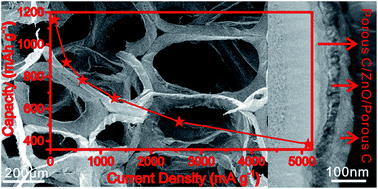Sandwiched porous C/ZnO/porous C nanosheet battery anodes with a stable solid-electrolyte interphase for fast and long cycling†
Abstract
Producing carbon/transition metal oxide composites is a promising strategy for improving the stability of high energy alkali-ion batteries. However, fracture of the thin carbon layer by enormous volume change of the oxide and sluggish ion transport in the composite lead to premature cell failure. In this study, we show that anodes consisting of an active ZnO nanosheet sandwiched between two layers of porous thick carbon coating can cycle over 1650 times without obvious capacity decay. The outer thick carbon coating with mechanical robustness suppresses the expansion of the inner oxides without cracks, resulting in a stable SEI layer. Its porous structure and conductive nature also facilitate Li+/electron transportation into the inner oxides. The battery containing composite nanosheets shows a fast and high capacity of 330 mA h g−1 at 5000 mA g−1. We notice that a critical thickness ratio of ZnO to the carbon layer may exist, and the carbon layer is prone to fracture in the case of large thickness ratio. The results have important applications in designing carbon/metal oxide composites for high performance anodes of Li-ion batteries.



 Please wait while we load your content...
Please wait while we load your content...